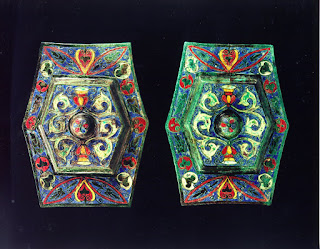Triumphal regalia
In Republican Rome, truly exceptional military achievement merited the highest possible honors, which connected the vir triumphalis ("man of triumph", later known as a triumphator) to Rome's mythical and semi-mythical past. Triumphs were tied to no particular day, season, or religious festival of the Roman calendar. Most seem to have been celebrated at the earliest practical opportunity, probably on days that were deemed auspicious for the occasion. Tradition required that, for the duration of a triumph, every temple was open. The ceremony was thus, in some sense, shared by the whole community of Roman gods, but overlaps were inevitable with specific festivals and anniversaries.
The dates selected for some triumphs may have been coincidental with other official festivals while others were maneuvered to coincide. For example, March 1, the festival and dies natalis of the war god Mars, was the traditional anniversary of the first triumph by Publius Valerius Publicola (504 BCE), who, along with Lucius Junius Brutus, led the overthrow of the monarchy, as well as six other Republican triumphs, and of the very first Roman triumph by Romulus.
According to Plutarch, Romulus' first Roman triumph complete with chariot and the "kingly" garb of the triumphator celebrated the defeat of King Acron of the Caeninenses, and is thought to coincide with Rome's foundation in 753 BCE. Like much in Roman culture, elements of the triumph were based on Etruscan and Greek precursors. In particular, the purple, embroidered toga picta worn by the triumphal general was thought to be derived from the royal toga of Etruscan kings. Arrian, however, attributes similar Dionysian elements to the emulation of a victory procession of Alexander the Great.
Roman historians from the Principate identify the association of a triumph with Alexander the Great to the celebration of the victories of Scipio Africanus. The triumphal general was also linked to the demi-god Hercules, who had labored selflessly for the benefit of all mankind. His sumptuous triumphal chariot was bedecked with charms against the possible envy (invidia) and malice of onlookers. Of course, the demeanour of a triumphal Republican general would have been closely scrutinised by his aristocratic peers, as well as the symbols which he employed in his triumph. They would be alert for any sign that he might aspire to be more than "king for a day".








Comments
Post a Comment